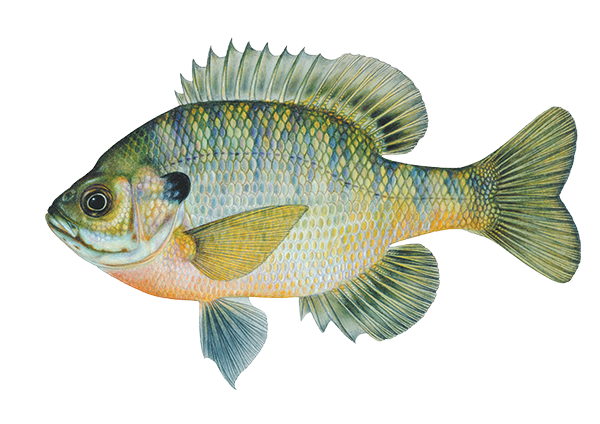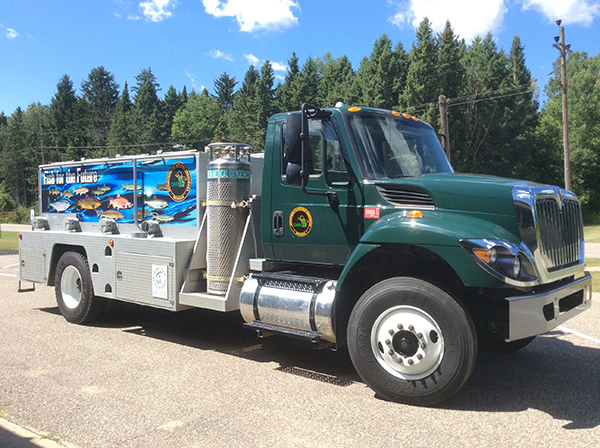|
This e-newsletter is made specifically for students, parents and teachers. Expect to receive Fish Bites about four times each year and have your friends sign up, too!
 Can you name this species? Scroll to the bottom of the email to learn more!
Illustration by Joseph R. Tomelleri ©
- February 19 & 20: Free Fishing Weekend
- Interested in learning how to ice fish, or getting some tips and tricks from the pros to improve your hard-water fishing success? The DNR Outdoor Skills Academy – which offers in-depth, expert instruction, gear and hands-on learning – has several ice fishing classes this winter. For more details and registration information for the following classes, go to Michigan.gov/OutdoorSkills.
- When our lakes ice over and the water gets very, very cold, many fish species "slow down" and don't eat as much as compared to the summer.
- Lake sturgeon are the largest fish native to the Great Lakes.
- More than 180 non-native aquatic species have established themselves in the Great Lakes since the 1800s.
- Most fish cannot swim backwards. Those that can are mainly members of one of the eel families.
Do you enjoy being outdoors? Do you like to fish? Do you want to learn about fishing in Michigan? Join the Youth Fishing Academy for this exciting opportunity to increase your fishing knowledge! Free fishing gear, guest speakers, and more!
The Saginaw 4-H Youth Fishing Academy will provide FREE monthly workshops where youth from across the region will have opportunities to build connections with other youth who share their fishing and outdoor interests, learn a variety of angling skills, and cultivate conservation knowledge and fishing ethics. Activities will include rod making, tackle crafting, fly tying, casting, rod rigging, fishing games and more.
Each session will include a presentation from local fishing experts and will be followed by a hands-on fishing project.
Pre-registration is required. The program is open to all youth ages 8-19. 4-H membership is NOT required. Participants may choose to attend any or all of the sessions. Space is limited so register early for this opportunity.
 In fall 2021, the Michigan Department of Natural Resources stocked eight different fish species totaling 672,478 fish that weighed nearly 13.5 tons. Fish were stocked at 123 locations throughout the state.
The number and type of fish stocked varies by hatchery as each facility’s ability to rear fish differs because of water supplies and temperature. In Michigan, there are six state and three cooperative hatcheries that work together to produce the species, strain and size of fish needed by fisheries managers. These fish must then be delivered at a specific time and location for stocking to ensure their success. Most fish in Michigan are stocked in the spring.
Fall fish stockings in 2021 consisted of eight species that included: brook trout, brown trout, channel catfish, coho salmon, lake trout, Eagle Lake and steelhead strain rainbow trout, walleye and muskellunge.
- Marquette State Fish Hatchery (near Marquette) stocked 38,003 fall fingerling and adult brook and lake trout that weighed a combined 8,018 pounds. These fish were stocked at a total of 46 locations, both in the Upper and Lower Peninsula.
- Oden State Fish Hatchery (near Petoskey) stocked 37,000 Wild Rose brown trout and 113,863 Eagle Lake rainbow trout fall fingerlings that weighed a combined 4,093 pounds. These fish were stocked at total of four locations.
- Platte River State Fish Hatchery (west of Traverse City) stocked 70,194 fall fingerling coho salmon weighing 2,999 pounds. These salmon were stocked in the East Branch of the AuGres River located in Iosco County.
- Thompson State Fish Hatchery (near Manistique) stocked 349,213 fall fingerling steelhead that weighed 3,810 pounds at four locations. In addition, the first year of musky production was a success at Thompson, stocking 20,037 fish at 12 locations.
- Wolf Lake State Fish Hatchery (west of Kalamazoo) stocked 9,850 Great Lakes strain muskellunge fall fingerlings that weighed 1,083 pounds and were stocked at 13 locations.
- Several Fisheries Management Units (Northern Lk Michigan, Southern Lk Michigan, Central Lk Michigan, Lk Erie, and Southern Lk Huron) also stocked fall fingerling walleyes in 2021. The Northern Lake Michigan Management unit stocked 4,927 Bay De Noc strain fall fingerlings weighing 730 pounds. While the Lake Erie, Southern and Central Lake Michigan management units stocked 23,133 Muskegon strain fall fingerlings weighing 2,108 pounds.
- Three sites were stocked with a total of 5,035 channel catfish from Ohio, with a total weight of 1,014 pounds. These fish were part of an annual agreement that includes Michigan providing Ohio with steelhead eggs in exchange for fall fingerling channel catfish.
- Also as part of an annual cooperative exchange, 2,123 Northern strain muskellunge from the Wisconsin DNR weighing 685 pounds were stocked at four locations located in both the Upper and Lower peninsulas. Michigan DNR provided Wisconsin with Great Lakes strain muskies in exchange for these fish.
In general, fish are reared in Michigan’s state fish hatcheries anywhere from one month to one and a half years before they are stocked.
The DNR welcomes visitors to its state fish hatcheries and interpretative centers to witness first-hand the fish rearing process and to learn about Michigan’s waters. For more information, visit michigan.gov/hatcheries.
To find out if any fish were stocked in your favorite fishing spot, visit the DNR’s fish stocking database at michigandnr.com/fishstock/.
Salmon in the Classroom is not just another science activity, but a very interactive, participatory program in which students raise salmon and ultimately are responsible for their survival and release. If you are, or know, a classroom teacher interested in joining this program, please know that it is a school-year-long commitment! Fish need to be fed multiple times a day and aquariums need to be cleaned regularly. Salmon in the Classroom applications are due each year between Jan. 1 through April 15. The program is for 3rd grade classrooms and higher. For more information, visit Michigan.gov/SIC.
 Bluegill have two broadly-joined dorsal fins with spinous and soft-rayed portions united to give the impression of a single dorsal fin, small mouth, long pointed pectoral fins, faint black spot toward the rear of the soft-rayed part of dorsal fin separates the bluegill from other sunfish, which lack this dorsal coloration. Bluegill spawn in the shallows in the late spring or early summer when the water temperature reaches 65 degrees. Males build nesting colonies in gravel, sand or mud and will guard the eggs and newly hatched fry until they reach the swimming stage. The average adult bluegill is 6 to 8 inches long, although some reach 10 inches. Sexual maturity occurs at 2 to 3 years for males and 3 to 4 years for females. Average life-span of these fish is 5 to 6 years.
|